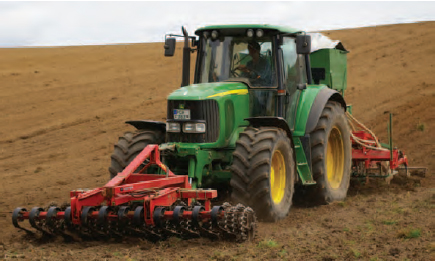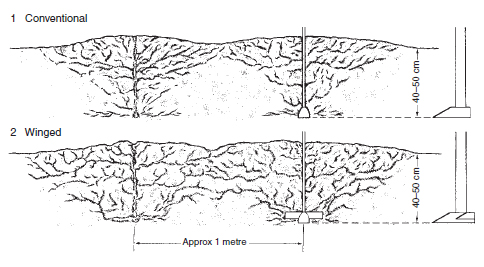Cultivations
ContentIn temperate areas, the conventional preparation of land for planting is a thorough disturbance of the top 20–30 cm of soil. Digging or ploughing buries residues of previous plantings and weeds, and with repeated passes of rakes or harrows a suitable tilth is created. This procedure is very demanding on energy, labour and time. Many of the cultivations tend to interfere with the natural structure-forming agents and when undertaken at the wrong time they create pans or leave a bare, loose soil vulnerable to erosion (see soil structure). Some of the compaction problems are overcome by cultivating in beds which confines traffic to well-defined paths between the growing areas. The advent of effective herbicides has, in certain cases, enabled the inversion of soil to be eliminated. The use of powered implements has speeded up work and reduced the number of tillage passes. In some areas of horticulture the adoption of minimum or zero tillage has preserved natural structure while beneficially concentrating organic matter levels in the surface layers and reducing wind and water erosion. Ploughing and digging Ploughing and digging are used to loosen and invert the soil. The land is broken up into clods and an increased area is exposed to weathering. As the soil is inverted, weeds, plant residues and bulky manures are incorporated. The depth of ploughing or digging should be related to the depth of topsoil, because bringing up the subsoil reduces fertility in the vital top layers, seriously affecting germination of seeds and establishment of plants. If deeper layers are to be loosened a subsoiler should be used. In plastic soil conditions the plough can smear the soils, more so if the wheels of the tractor spin in the furrow bottom. These plough pans tend to develop with successive ploughing to the same depth. Ploughing at different depths or attaching a subsoil tine can reduce their incidence. Digging with a spade does not produce a cultivation pan and is still used on small areas. Spading machines or rotary diggers imitate the digging action without the disadvantages of ploughing, but tend to be very slow. Rotary cultivators Rotary cultivators are used to create a tilth on uncultivated or on roughly prepared ground. The type of tilth produced depends on suitable adjustment of forward speed, rotor speed, blade design and layout, shield angle and depth of working. The ‘hoe’ blade is normally used for seedbed production, but does have the disadvantage of smearing plastic soils at the cultivation depth, producing a rotovation pan. ‘Pick’ tines produce a rougher tilth, but less readily cause a pan. Subsoil tines can be fitted to prevent these pans developing.
Harrowing and raking are methods of levelling soils, incorporating fertilizers and producing a suitable tilth on the roughly prepared ground. The soil must be in a friable condition for this operation and it is made easier if the top layers have been suitably weathered. The impact of the tines breaks the clods. The number of passes to create a seedbed has been reduced by the use of rotavators and other equipment that completes several of the stages in one pass (see Figure 17.15). ‘Progressive’ type cultivators were introduced essentially to loosen coarse structured clays by drawing through the soil banks of tines, increasing in depth from the front, to cultivate the soil from the top down in one pass. Although this requires powerful tractors to pull, especially if subsoiling tines are attached, it is a time-saving operation and the recompaction inherent in multiple pass methods is reduced. These cultivators should not be used on well-structured soils where full depth loosening is unnecessary. ‘Under-loosening’ cultivators have been designed to loosen compact topsoils without disturbing the surface, which ensures a level, clod-free and organic-matter-rich tilth. Used under the right conditions these implements improve water movement and plant growth. However, loosened soils are more susceptible to compaction and consequently the equipment should only be used when compaction is known to be present. Subsoiling Subsoiling is used to improve soil structure below plough depth by drawing a heavy cultivation tine through the soil to establish a system of deep cracks in compacted zones. This helps the downward movement of water, circulation of air and penetration of roots (see Figure 17.16 ). The operation is most effective when the subsoil is friable and the surface dry enough to be able to withstand the heavy tractor that is needed (see loadbearing).
Subsoiling should only be used when the cause of any waterlogging is related to a soil structure fault (see also drainage). Slow subsoil permeability caused by high clay content is usually rectified with mole drainage. If the soil is too sandy or stony, a subsoiler can be used so long as the cracks created lead the water into a natural or artificial drainage system. Subsoilers used in the right conditions readily burst massive structures and soil pans created by machinery, but some natural pans are too strong for normal equipment. The problem of cultivation pans can be dealt with by using conventional subsoilers or by attaching small subsoil tines to the cultivation equipment. This tends to increase the power requirement but eliminates the pan as it is created. |






